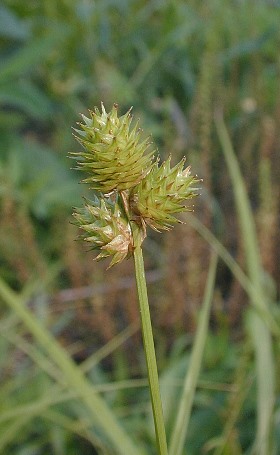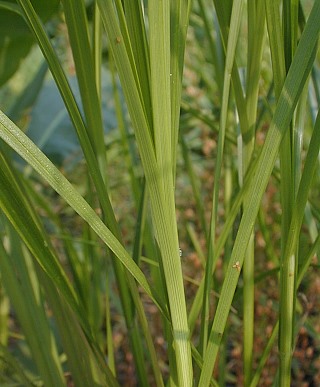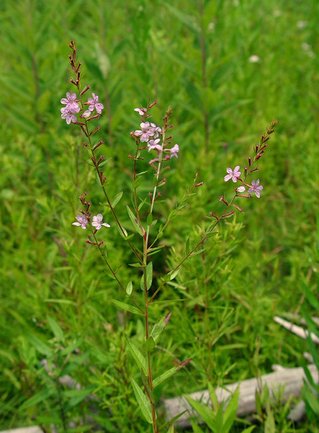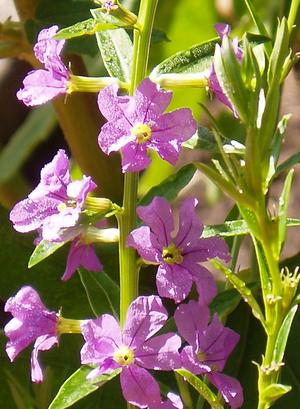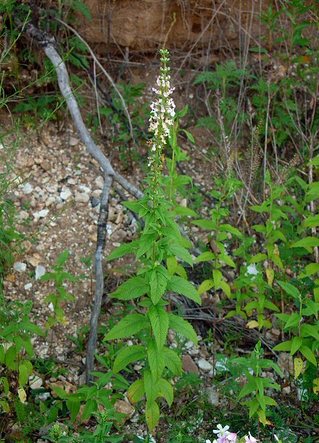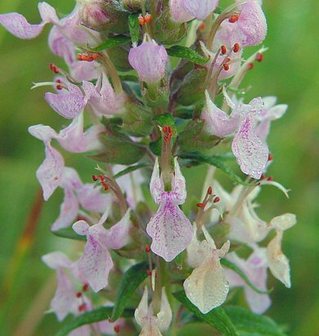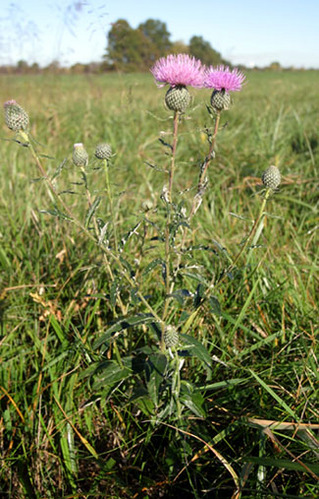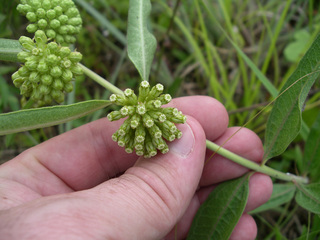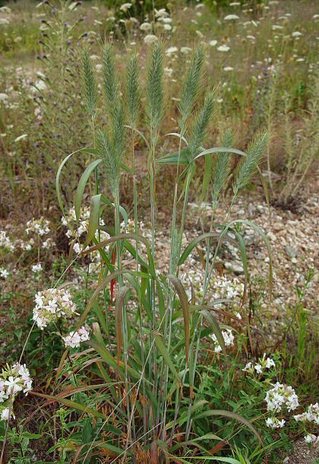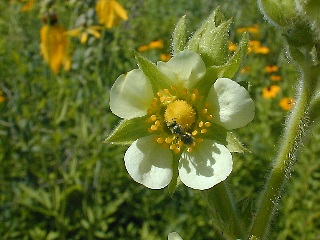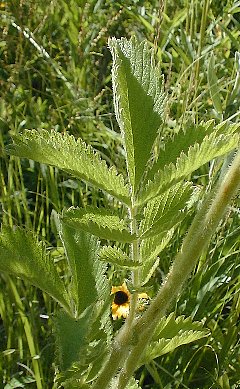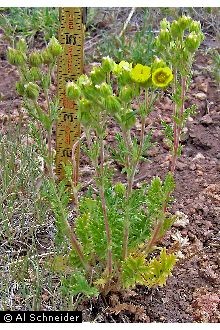|
|
Here’s what needs to be done tomorrow, around 10am, for pollinating Cirsium altissimum at Hegg Lake.
I will provide a clipboard with a data sheet, map, and pollinating tools. Plant numbers are on flags to the south of the plants. Plant 9-7 has a yellow twist-tied head that is flowering right now. It will need to be selfed. Yellow tt heads on plants 9-16,-6, and -8 may be flowering tomorrow. If so, they also need to be selfed. Plant 9-19 had two bagged yellow heads. One is done flowering, the other may be flowering tomorrow. If the second one is flowering, it should be selfed. 9-26 with a red tt may be flowering. If so, it needs to be crossed. Cross pollen can be obtained from 9-14, which has a white tt and is blooming now, or 9-21, which may be flowering tomorrow.
To pollinate the heads, use a q-tip provided. For selfing, just rub the q-tip over the anthers to collect the pollen, then brush the q-tip on the stigmas. The pollen is very sticky and will easily stick to the q-tip. For crossing, rub a q-tip on the anthers of a pollen donor (white tt). Place in a labeled glass vial, transport to the head to be crossed, and rub the stigmas with the q-tip. Be sure to write down which plant was used as a pollen donor.
August looks like it will be my busiest month this summer. I’m currently working on four species, and will expect to start two more before the end of the month. Here’s the status of my species so far.
Pediomelum esculentum- I have collected fruit from all of my experimental plants. I have not started to count seed yet.
Dichanthelium oligosanthes- I have finished collecting fruit and am in the process of counting seed. From what I’ve seen so far, D. oligosanthes is SC, although I can’t rule out agamospermy.
Asclepias viridiflora- These plants are also in fruit. Of my selfed flowers, only one has remained on the peduncle. I doubt it will turn into a fruit, which could mean one of two things: A. viridiflora is SI, or I’m not qualified to be an Asclepias pollinator.
Potentilla arguta- My plants have finished flowering and are in fruit. I’m waiting for them to mature so I can start collecting.
Panicum capillare- I have about twelve inflorescences bagged and am trying to get the “styles on agar” method to work.
Cirsium altissimum- There are lots of plants and will be over a hundred heads to work with out at Hegg Lake. At this point none have flowered yet, but I have them all flagged, twist-tied, and ready to go.
Potentilla pensylvanica- I have been pollinating these at Glacial Lakes State Park for a few days now. They don’t flower a lot and they are nearing the end of flowering, but I believe I will manage to get enough pollinated before they finish. Either way, Glacial Lakes is a beautiful place to be doing field work!
Teucrium canadense- While checking out some Carex yesterday I discovered Teucrium growing at the back hill. There were enough plants to work with and not yet done flowering, so I flagged and bagged today. Tomorrow I will begin pollinations.
I also expect to be working with at least Muhlenbergia cuspidata and Solidago speciosa before the summer ends.
On July 20th I collected pollen,separated into three microfuge tubes, from plant 36, 958. Tube #1 has been left at room temperature, #2 is in the refrigerator, and #3 is in the freezer. There wasn’t much pollen available, so I hope it’s enough to try some pollinations and see how long the pollen stays viable under the three treatments.
This is my first trip up to Minnesota this year. My goal is to locate populations of the species I want to work on this summer.
I spent yesterday afternoon and this morning at Glacial Lakes State Park in Pope County. There was quite a bit blooming along the trail. There was a fairly common Viola with deeply divided leaves, unfortunately not the one I want to work with. I saw at least three Astragalus species, two of which are past their prime and another low-growing species with white flowers. Only a few of the white-flowered plants were in bloom. Geum triflorum is already in fruit as well as Antennaria, and Zizia is just starting to flower. There were two Lithospermums throughout the park, both common. One had lemon yellow crenulate corollas and the other had dark yellow flowers and darker foliage. I saw two Carex, one really short one and a taller one, both in bloom. I believe neither are the species I’m looking for. There was a lot of a white flowered caryoph, which got me excited because I thought it might be Silene antirrhina, but it wasn’t. I’m not sure what species it is, let alone genus. I stayed at Baby Lake campground last night because there had been a collection of Lomatium orientale near Baby Lake, but I had no luck in locating any plants. There are some dry hills a little farther from the trail that I wish I could explore, because they seem like the kind of habitat in which I might find a Lomatium.
This morning and early afternoon I spent around the farm and at some roadside sites. I checked out a gravel mine for Lomatium, but I didn’t find any. There was very little vegetation at all there. I did have luck finding the spot at Loeffler’s corner where Stuart said there would be some Stipa comata, but the clumps haven’t started forming inflorescences yet. Hegg Lake has mostly been burned, so my visit there was short. I did find a small hill near the road that escaped the burn. Nothing up there interested me except some Stipa, which is probably S. spartea and not S. comata. Overall, it’s been a disappointing day, especially because I couldn’t get into landfill. Perhaps tomorrow will be more fruitful.
Our excellent photographer, Christine, took some awesome photos of plants at the landfill. I’ll update the scientific names when I get them identified.

Immature Asclepias fruits

Artemesia

Urtica. Most definitely Urtica.

Anyone know what this is?

Sorghastrum?

Allium
Today was the fourth collecting trip to the Pope-Douglas County landfill. What a beautiful day for collecting! And what diversity! There were many new plants I had not seen, some that have yet to begin flowering. I lament not being able to stay longer and collect more. I’m sure I could add 50 more species. I’ll definitely be back next year and start earlier to get a full species list for the site. For those of you who have missed out on seeing some of the fascinating plants out there, pictures from today’s collecting trip, courtesy of Christine, will be forthcoming. As for the collections (including a nettle that still has my thumb stinging), I made 27 collections, including big bluestem, side-oats gramma, dahlia, onion, honeysuckle, sage, ragweed, goat’s beard, milkweed, sweet clover, golden alexander, and goldenrod. Who knew I’d ever make visiting a landfill a habit?
|
|

